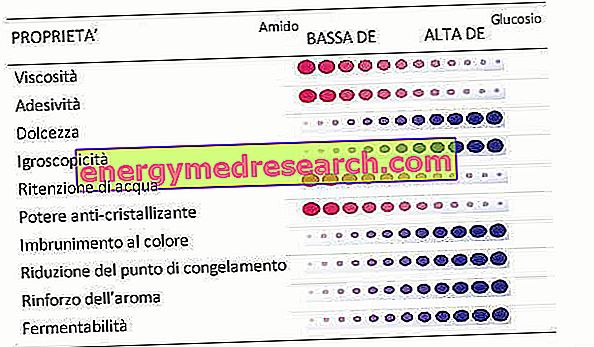Definition
Dextrose equivalence is a parameter that expresses the degree of hydrolysis of starch and carbohydrates derived from it.
Introduction - Let us briefly recall how carbohydrates are divided into:
- monosaccharides: vulgarly and very generically called "sugars", or more correctly simple carbohydrates; they represent the simplest units, from the concatenation of which carbohydrates are formed more and more complex; characteristic examples are glucose (or dextrose), fructose, galactose, etc.
- oligosaccharides: also defined as simple carbohydrates, they consist of the concatenation of several monosaccharides (from two units - in this case we speak of disaccharides - up to a maximum of 20 monomers); characteristic examples are lactose (glucose + galactose), maltose (glucose + glucose), maltotriose (glucose + glucose + glucose) and dextrins (5-10 units of glucose).
- polysaccharides: often called "complex carbohydrates", they are characterized by the union of a large number of monosaccharides; starch and glycogen are the most common complex carbohydrates.
Dextrose equivalence is expressed with a numerical value ranging from 0 (complex starch) to 100 (glucose); this number depends on the length of the monomers present in the starch and its hydrolysis products.
- DEGROSITY EQUIVALENCE (DE near 100) is the HIGHEST, the length of the glucidic chain is lower (greater degree of hydrolysis)
- Both MINOR is dextrose equivalence (DE near 0), so MOST is the length of the carbohydrate chain (lower degree of hydrolysis)
According to the above, glucose is characterized by the maximum dextrose equivalence (DE = 100) while the value is very low in starch (DE tending to 0). Dextrose equivalence increases as starch is "broken down" (hydrolyzed) into smaller chains; it will therefore be greater in maltodextrins and even greater in dextrins, maltotriose, maltose and glucose
In technical terms, dextrose equivalence is a measure of the amount of reducing sugars present in a carbohydrate, expressed as glucose (or dextrose, if you prefer), per 100 grams of dry substance in the product. For example, a maltodextrin with DE equal to 10 has a reducing capacity equal to 10% of that of dextrose.
Importance of dextrose equivalence in the food industry
Dextrose equivalence is a very important parameter for the food industry, so much so that it falls within the regulation of particular foods, such as glucose syrup, which by law must have a dextrose equivalence within a range of predetermined values.
In fact, as the dextrose equivalence increases, the sweetness of the product, its solubility, fermentability, the risk of browning and the ability to lower the freezing point also increase (a particularly important aspect in the confectionery industry). Conversely, low-DE polymers are less soluble, less sweet, more viscous and have no effect on the freezing point, at most they elevate it.

Dextrose equivalence and carbohydrate supplements
In clinical and sports nutrition, dextrose equivalence is used as a general parameter to evaluate the glycemic index of carbohydrate-based products, generally known as maltodextrins.
From what has been said, the higher the value of Dextrose-Equivalence, the shorter are the chains of monosaccharides present in the product; theoretically at least, therefore, high-DE products will have a higher glycemic index than those with a low DE, since less will be the digestive commitments to transform them into absorbable monosaccharides. It should however be pointed out that the glycemic index of maltodextrins and refined derivatives of starch is always high, similar to that of glucose even in the case of low dextrose equivalence. We are indeed talking about extremely refined carbohydrates, lacking the most important elements (such as fiber, fats, proteins and anti-nutritional factors) capable of lowering the glycemic index. Furthermore, we have seen how dextrose-rich solutions, by virtue of the osmotic effect (recall of water in the digestive system) are absorbed more slowly than isocaloric solutions of starch hydrolysates, also very complex like the vitargo (which stands out for its presence of numerous branching points, with high percentages of amylopectin, another fundamental element in decreeing its high glycemic index despite the very low dextrose equivalence).



